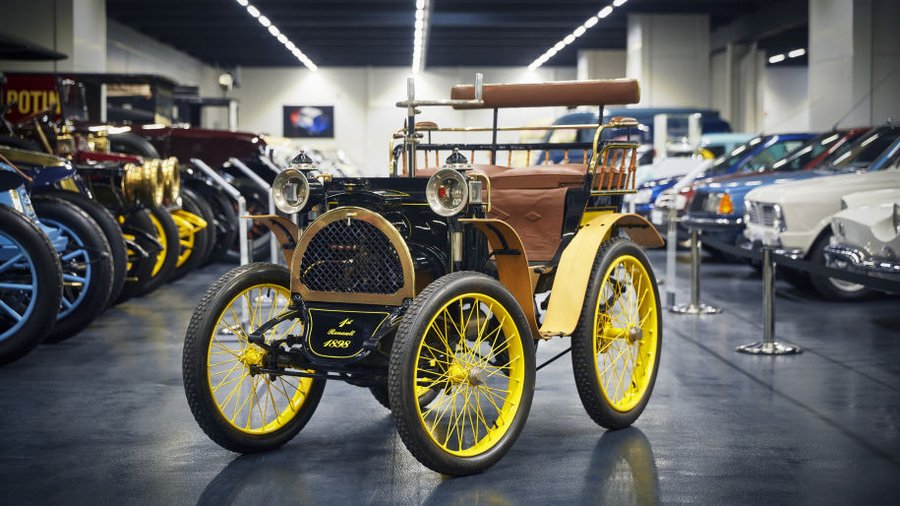It was created on a bet
Elon Musk has ambitions to blast into space; his 19th century French equivalent – a 21-year-old tech prodigy called Louis Renault – wanted to prove he could drive up the steepest street in Paris. The 'voiturette' he designed to do it featured new technology like a three-speed transmission and a direct driveshaft in place of the usual chain drive. And on Christmas Eve 1898, he drove it up the Rue Lepic to Montmartre on a bet. Onlookers were so impressed that several placed orders on the spot, and Renault the carmaker was born.
Its taxis stopped German advance in WW1
When his brother Marcel was killed in a race in 1903, Louis assumed control of the business, which by now had a workforce of 600 and annual production of nearly 1,000 cars. In 1905 Renault won the contract to build 1,500 taxis to serve Paris. A further 1,100 were sold for similar use in London, but it was the Type AG's role transporting troops to the WW1 battlefront and halting the German advance that earned it a place in French folklore and the name 'Taxi de le Marne'. Renault also built tanks, but it was his tough, reliable taxi that really saved the day.
It had moments of wonderful madness
The story of Renault is inextricably entwined with modern French history and, like many global powers, France wanted to project technological prowess around the world. The idea of a trans-Saharan tourist highway connecting French colonies in Algeria with those in the west of Africa inspired competition between Citroen and Renault. Citroen went with its Kégresse half-track while Renault created the wild-looking Type MH 6 Roues. A G-Class 6x6 for the roaring '20s, when the Renault caravan overtook Citroen's it was a decisive win for duallies.
It innovated its way out of the Great Depression
Louis Renault visited America in 1911 and in 1928 to see Ford's mass-production first-hand, but decided there wasn't yet a market in Europe for volume cars. So Renault stuck with building luxury cars, at least until the Great Depression hit and the combination of falling sales and an increasingly radicalised workforce forced the firm to innovate or die. The Juvaquatre of 1937 was light thanks to its unitary construction and gave Renault an affordable, cost-effective product to take on domestic rivals like the Citroen Traction Avant and Peugeot 202.
Collaboration brought shame, resistance resulted in the French Beetle
Volkswagen wasn't the only company to emerge from the ashes of WW2 with a rear-engined 'people's car', nor was it unique in facing awkward truths about wartime sponsors. Previously hailed as a saviour, Louis Renault was condemned as a collaborator for permitting Daimler-Benz to run his factories on behalf of the Nazi war effort. This attracted both public shame and 8th Air Force bombs, his death in custody in 1944 followed by the state seizing control of his company. All the while Renault engineers had been planning for post-war mobility and in 1946 the 4CV they had been secretly working on was launched to the world – US included. Volkswagen triumphed Stateside but the 4CV, like the Beetle, helped Europe get mobile again.
It invented the hatchback
With a degree of French hubris post-war Renault considered itself more than just a manufacturer – it was an extension of the state and through its cars could influence social change. Tour the classic department's 'le garage' with a Renault-appointed historian and you'll hear claims it invented both the SUV and hatchback as the rear-engined sedans of the Dauphine area were replaced with five-door cars designed to adapt to people's changing lives. Definitive of these was the 'blue jean' Renault 4, so-called for its fashionable and unpretentious ubiquity.
It turned American teen rebellion into the definitive European supermini
For a company so defined by its Frenchness American influence on Renault has been strong. This was personified in Bernard Hanon, later nicknamed 'L'Américain' for buying into AMC to maintain Stateside presence with cars like the Renault Alliance and Encore. An economics graduate of University of Columbia, he returned to France from a spell teaching management at New York University as student riots took hold in Paris. Fired up by American youth culture he proposed a stylish, affordable car for a generation rejecting the tastes and ideals of their parents. Late '60s sketches were made real in 1971 with the Renault 5, a template for European superminis that lives to this day ... and it was all inspired by America.
It made an F1-powered minivan
Hanon's influence was also all over another high-minded attempt by Renault to build 'cars for life'. The Espace minivan (pictured above) took an earlier maxim of maximising internal volume to its purist, one-box extreme and combined inventive material choice with infinitely configurable seating. The minivan was born. And then it was corrupted in spectacular style to celebrate a third consecutive F1 constructors' championship with Williams in 1994. With the engine and running gear of the 1992 Williams FW14 underneath a vanlike façade, the Espace F1 (as seen in the first slide) is all Renault stands for in one car, be that creator of inventive vehicles in tune with society's needs to attention-seeking technological provocateur with an eye for killer publicity stunts.

